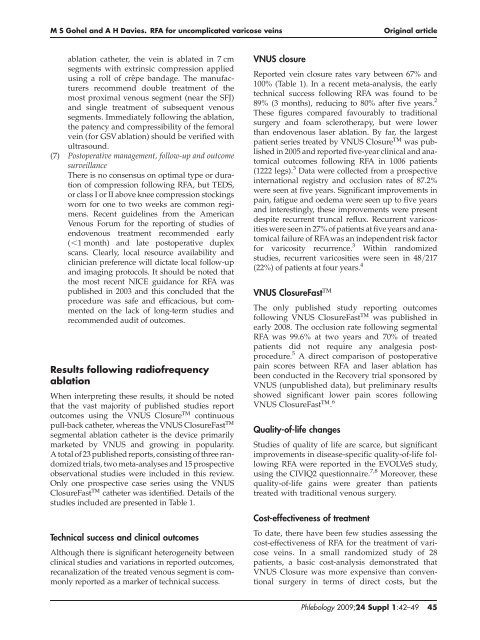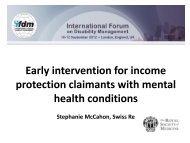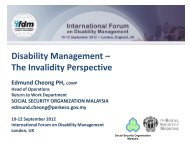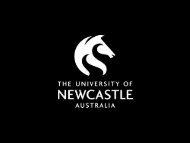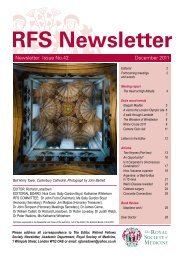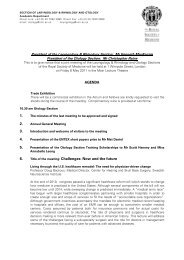Radiofrequency ablation for uncomplicated varicose veins
Radiofrequency ablation for uncomplicated varicose veins
Radiofrequency ablation for uncomplicated varicose veins
Create successful ePaper yourself
Turn your PDF publications into a flip-book with our unique Google optimized e-Paper software.
M S Gohel and A H Davies. RFA <strong>for</strong> <strong>uncomplicated</strong> <strong>varicose</strong> <strong>veins</strong> Original article<br />
<strong>ablation</strong> catheter, the vein is ablated in 7 cm<br />
segments with extrinsic compression applied<br />
using a roll of crêpe bandage. The manufacturers<br />
recommend double treatment of the<br />
most proximal venous segment (near the SFJ)<br />
and single treatment of subsequent venous<br />
segments. Immediately following the <strong>ablation</strong>,<br />
the patency and compressibility of the femoral<br />
vein (<strong>for</strong> GSV <strong>ablation</strong>) should be verified with<br />
ultrasound.<br />
(7) Postoperative management, follow-up and outcome<br />
surveillance<br />
There is no consensus on optimal type or duration<br />
of compression following RFA, but TEDS,<br />
or class I or II above knee compression stockings<br />
worn <strong>for</strong> one to two weeks are common regimens.<br />
Recent guidelines from the American<br />
Venous Forum <strong>for</strong> the reporting of studies of<br />
endovenous treatment recommended early<br />
(,1 month) and late postoperative duplex<br />
scans. Clearly, local resource availability and<br />
clinician preference will dictate local follow-up<br />
and imaging protocols. It should be noted that<br />
the most recent NICE guidance <strong>for</strong> RFA was<br />
published in 2003 and this concluded that the<br />
procedure was safe and efficacious, but commented<br />
on the lack of long-term studies and<br />
recommended audit of outcomes.<br />
Results following radiofrequency<br />
<strong>ablation</strong><br />
When interpreting these results, it should be noted<br />
that the vast majority of published studies report<br />
outcomes using the VNUS Closure TM continuous<br />
pull-back catheter, whereas the VNUS ClosureFast TM<br />
segmental <strong>ablation</strong> catheter is the device primarily<br />
marketed by VNUS and growing in popularity.<br />
A total of 23 published reports, consisting of three randomized<br />
trials, two meta-analyses and 15 prospective<br />
observational studies were included in this review.<br />
Only one prospective case series using the VNUS<br />
ClosureFast TM catheter was identified. Details of the<br />
studies included are presented in Table 1.<br />
Technical success and clinical outcomes<br />
Although there is significant heterogeneity between<br />
clinical studies and variations in reported outcomes,<br />
recanalization of the treated venous segment is commonly<br />
reported as a marker of technical success.<br />
VNUS closure<br />
Reported vein closure rates vary between 67% and<br />
100% (Table 1). In a recent meta-analysis, the early<br />
technical success following RFA was found to be<br />
89% (3 months), reducing to 80% after five years. 2<br />
These figures compared favourably to traditional<br />
surgery and foam sclerotherapy, but were lower<br />
than endovenous laser <strong>ablation</strong>. By far, the largest<br />
patient series treated by VNUS Closure TM was published<br />
in 2005 and reported five-year clinical and anatomical<br />
outcomes following RFA in 1006 patients<br />
(1222 legs). 3 Data were collected from a prospective<br />
international registry and occlusion rates of 87.2%<br />
were seen at five years. Significant improvements in<br />
pain, fatigue and oedema were seen up to five years<br />
and interestingly, these improvements were present<br />
despite recurrent truncal reflux. Recurrent varicosities<br />
were seen in 27% of patients at five years and anatomical<br />
failure of RFAwas an independent risk factor<br />
<strong>for</strong> varicosity recurrence. 3 Within randomized<br />
studies, recurrent varicosities were seen in 48/217<br />
(22%) of patients at four years. 4<br />
VNUS ClosureFast TM<br />
The only published study reporting outcomes<br />
following VNUS ClosureFast TM was published in<br />
early 2008. The occlusion rate following segmental<br />
RFA was 99.6% at two years and 70% of treated<br />
patients did not require any analgesia postprocedure.<br />
5 A direct comparison of postoperative<br />
pain scores between RFA and laser <strong>ablation</strong> has<br />
been conducted in the Recovery trial sponsored by<br />
VNUS (unpublished data), but preliminary results<br />
showed significant lower pain scores following<br />
VNUS ClosureFast TM . 6<br />
Quality-of-life changes<br />
Studies of quality of life are scarce, but significant<br />
improvements in disease-specific quality-of-life following<br />
RFA were reported in the EVOLVeS study,<br />
using the CIVIQ2 questionnaire. 7,8 Moreover, these<br />
quality-of-life gains were greater than patients<br />
treated with traditional venous surgery.<br />
Cost-effectiveness of treatment<br />
To date, there have been few studies assessing the<br />
cost-effectiveness of RFA <strong>for</strong> the treatment of <strong>varicose</strong><br />
<strong>veins</strong>. In a small randomized study of 28<br />
patients, a basic cost-analysis demonstrated that<br />
VNUS Closure was more expensive than conventional<br />
surgery in terms of direct costs, but the<br />
Phlebology 2009;24 Suppl 1:42–49 45


